
Concept explainers
(a)
Interpretation:
The type of isomerism that could be exhibited by the given formulae and an example that illustrates the specific type of isomerism has to be stated.
Concept introduction:
Organic compounds which have similar chemical formula but different structures, i.e., the atoms are in a different spatial arrangement, they are known as structural isomers. Cis and Trans isomers are also structural or geometrical isomers.
(a)
Answer to Problem 2Q
Explanation of Solution
The type of isomerism that could be exhibited by
The structural isomer of
The given formula,
The root word hexene indicates that six carbon atoms are present in the parent chain. Double bond is present between first and second carbon.
The structure of 1-hexene is shown

The structural isomer of
The given formula,
The root word hexene indicates that six carbon atoms are present in the parent chain. The number
The structure of 2-hexene is shown

The structural isomer of
The given formula,
The root word hexene indicates that six carbon atoms are present in the parent chain. The number
The structure of 3-hexene is shown

The structural isomer of
The given formula,
The root word pentene indicates that five carbon atoms are present in the parent chain. The number
The structure of

The structural isomer of
The given formula,
The root word butene indicates that six carbon atoms are present in the parent chain. The double bond is present between second and third carbon. Two methyl groups are attached at second and third carbon.
The structure of
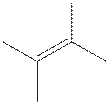
The geometric isomer of
The structure of cis-2-hexene is,
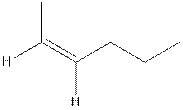
The structure of trans-2-hexene is,
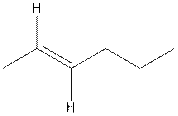
In the cis isomer, the two hydrogen of the double bonded carbons are adjacent to each other while in trans isomer, they are opposite to each other.
The geometric isomer of
The structure of cis-3-hexene is,
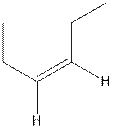
The structure of trans-3-hexene is,
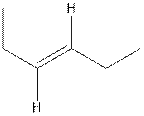
In the cis isomer, the two hydrogen of the double bonded carbons are adjacent to each other while in trans isomer, they are opposite to each other.
(b)
Interpretation:
The type of isomerism that could be exhibited by the given formulae and an example that illustrates the specific type of isomerism has to be stated.
Concept introduction:
Organic compounds which have similar chemical formula but different structures, i.e., the atoms are in a different spatial arrangement, they are known as structural isomers. Cis and Trans isomers are also structural or geometrical isomers.
(b)
Answer to Problem 2Q
Explanation of Solution
The type of isomerism that could be exhibited by
The structural isomer of
The root word pentane indicates that five carbon atoms are present in the parent chain. Hydroxyl group is attached to first carbon.
The structure of pentan-1-ol is shown,

The structural isomer of
The root word butane indicates that four carbon atoms are present in the parent chain.
The structure of

The structural isomer of
The root word propane indicates that three carbon atoms are present in the parent chain.
The structure of 2-ethoxypropane is shown

The structural isomer of
The root word butane indicates that four carbon atoms are present in the parent chain.
The structure of 2-methoxybutane is shown

The structural isomer of
The root word pentane indicates that five carbon atoms are present in the parent chain. Hydroxyl group is attached to third carbon.
The structure of pentan-

The structural isomer of
The root word pentane indicates that five carbon atoms are present in the parent chain. Hydroxyl group is attached to second carbon.
The structure of pentan-

(c)
Interpretation:
The type of isomerism that could be exhibited by the given formulae and an example that illustrates the specific type of isomerism has to be stated.
Concept introduction:
Organic compounds which have similar chemical formula but different structures, i.e., the atoms are in a different spatial arrangement, they are known as structural isomers. Cis and Trans isomers are also structural or geometrical isomers.
(c)
Answer to Problem 2Q
Explanation of Solution
The type of isomerism that could be exhibited by
The structural isomer of
In

The structural isomer of
In
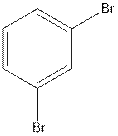
The structural isomer of
In

Want to see more full solutions like this?
Chapter 22 Solutions
Chemistry with Access Code, Hybrid Edition
- Draw product A, indicating what type of reaction occurs. NH2 F3C CF3 NH OMe NH2-NH2, ACOH Aarrow_forwardPhotochemical smog is formed in part by the action of light on nitrogen dioxide. The wavelength of radiation absorbed by NO2 in this reaction is 197 nm.(a) Draw the Lewis structure of NO2 and sketch its π molecular orbitals.(b) When 1.56 mJ of energy is absorbed by 3.0 L of air at 20 °C and 0.91 atm, all the NO2 molecules in this sample dissociate by the reaction shown. Assume that each absorbed photon leads to the dissociation (into NO and O) of one NO2 molecule. What is the proportion, in parts per million, of NO2 molecules in this sample? Assume that the sample behaves ideally.arrow_forwardCorrect each molecule in the drawing area below so that it has the skeletal ("line") structure it would have if it were dissolved in a 0.1 M aqueous solution of HCI. If there are no changes to be made, check the No changes box under the drawing area. No changes. HO Explanation Check NH, 2 W O :□ G ©2025 M unter Accessibilityarrow_forward
- An expression for the root mean square velocity, vrms, of a gas was derived. Using Maxwell’s velocity distribution, one can also calculate the mean velocity and the most probable velocity (mp) of a collection of molecules. The equations used for these two quantities are vmean=(8RT/πM)1/2 and vmp=(2RT/M)1/2 These values have a fixed relationship to each other.(a) Arrange these three quantities in order of increasing magnitude.(b) Show that the relative magnitudes are independent of the molar mass of the gas.(c) Use the smallest velocity as a reference for establishing the order of magnitude and determine the relationship between the larger and smaller values.arrow_forwardThe reaction of solid dimethylhydrazine, (CH3)2N2H2, and liquefied dinitrogen tetroxide, N2O4, has been investigated for use as rocket fuel. The reaction produces the gases carbon dioxide (CO2), nitrogen (N2), and water vapor (H2O), which are ejected in the exhaust gases. In a controlled experiment, solid dimethylhydrazine was reacted with excess dinitrogen tetroxide, and the gases were collected in a closed balloon until a pressure of 2.50 atm and a temperature of 400.0 K were reached.(a) What are the partial pressures of CO2, N2, and H2O?(b) When the CO2 is removed by chemical reaction, what are the partial pressures of the remaining gases?arrow_forwardOne liter of chlorine gas at 1 atm and 298 K reacts completely with 1.00 L of nitrogen gas and 2.00 L of oxygen gas at the same temperature and pressure. A single gaseous product is formed, which fills a 2.00 L flask at 1.00 atm and 298 K. Use this information to determine the following characteristics of the product:(a) its empirical formula;(b) its molecular formula;(c) the most favorable Lewis formula based on formal charge arguments (the central atom is N);(d) the shape of the molecule.arrow_forward
- How does the square root mean square velocity of gas molecules vary with temperature? Illustrate this relationship by plotting the square root mean square velocity of N2 molecules as a function of temperature from T=100 K to T=300 K.arrow_forwardDraw product B, indicating what type of reaction occurs. F3C CF3 NH2 Me O .N. + B OMearrow_forwardBenzimidazole E. State its formula. sState the differences in the formula with other benzimidazoles.arrow_forward
- Draw product A, indicating what type of reaction occurs. F3C CN CF3 K2CO3, DMSO, H₂O2 Aarrow_forward19) Which metal is most commonly used in galvanization to protect steel structures from oxidation? Lead a. b. Tin C. Nickel d. Zinc 20) The following molecule is an example of a: R₁ R2- -N-R3 a. Secondary amine b. Secondary amide c. Tertiary amine d. Tertiary amidearrow_forwardpls helparrow_forward
 ChemistryChemistryISBN:9781305957404Author:Steven S. Zumdahl, Susan A. Zumdahl, Donald J. DeCostePublisher:Cengage Learning
ChemistryChemistryISBN:9781305957404Author:Steven S. Zumdahl, Susan A. Zumdahl, Donald J. DeCostePublisher:Cengage Learning Chemistry: An Atoms First ApproachChemistryISBN:9781305079243Author:Steven S. Zumdahl, Susan A. ZumdahlPublisher:Cengage Learning
Chemistry: An Atoms First ApproachChemistryISBN:9781305079243Author:Steven S. Zumdahl, Susan A. ZumdahlPublisher:Cengage Learning


